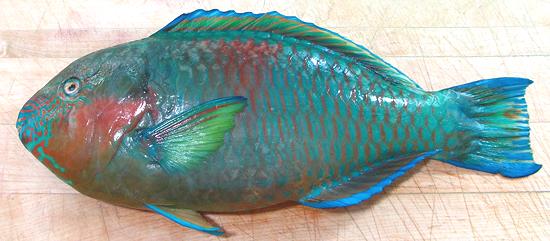 [Scarus rivulatus]
[Scarus rivulatus]
These West-Pacific fish are found in reef environments from Sri Lanka to New Caledonia and Tonga, north to the Ryukyu Islands, Japan, and south to New South Wales, Australia. These fish can grow to about 18 inches (TL), but the photo specimen was 13-5/8 inches long and weighed 1 pound 8-1/4 ounces.
Color schemes and patterns can vary radically. Young female fish are gray, but when they get larger and turn male they get a color scheme something like in the photo. The other fish packaged with this one was nearly black. This Parrotfish is fished commercially, and is IUCN Red Listed LC (Least Concern) - but their numbers are critically important to the health of Coral Reefs.
More on Parrot Fish
As you can see below, Parrotfish is a little more hassle than some fish to prepare, so why deal with Parrotfish? Well, because they have a unique combination of taste and texture. Parrotfish flesh is pure white in color, with no dark strip down the center under the skin. It's flavor is mild, but sufficiently interesting to be enjoyed by the fish connoisseur - yet not so assertive as to deeply offend those who want their fish "white and lite".
The flesh stays firm enough for any mode of cooking, but on the plate, can be flaked apart into unusually thick firm textured flakes.
Cooking: This fish needs to be cooked as skinless fillets, as its skin shrink is too severe to be controlled. For pan frying, I use just a dusting of rice flour and fry in a light oil so the true taste of the fish can be enjoyed. It also poaches very well. In both cases, use a very light sauce. This fish cooks firm enough it can be used in fish soups and stews.
Buying: Parrotfish show up fairly regularly in the Philippine fish markets here in Southern California, and a little less commonly in other Asian markets. It's not a fish you go out to buy, it's a fish you buy when you see it. The photo specimen, 1 pound 8-1/4 ounces, was purchased from the freezer cases (pack of 2) from an Asian market (Viet / Chinese) in Los Angeles (San Gabriel) for 2016 US $2.99 / pound.
Scales: This fish is completely covered with very large, stiff scales that have a lot of very tight overlap and fairly strong adhesion, but they are flexible enough to be scraped off with some effort, though you may need to pull a few with long nose pliers. They will fly around a lot.
Cleaning: This is not the easiest fish to clean as there are some tough membranes that aren't easy to pull out, and the gills are hard to get to. Use your long nosed pliers. You will find a set of millstones in the throat, used to crush coral pebbles into sand to extract food.
Fillet: This fish is fairly easy to fillet, with an easy to follow bone structure. When you get to the rib cage, it is easiest to cut the ribs from the backbone with kitchen shears and pull them from the fillet. Pulled lengthwise they pull out easily taking almost no flesh with them. There are some substantial sharp centerline pinbones for the full length of the rib cage. Pull these out straight forward. The lower belly is very thin and lined with soft fat. Best to cut the thin part off to make skinning easier.
Skin: The skin shrinks very severely when heated, it doesn't let go, and it doesn't soften until the damage is done. Trying to hold a fillet flat when it's turned skin side down is futile, the skin just pulls the fillet into a lump. Fortunately, the skin is tough, enough to be easily removed cleanly using the long knife and cutting board Method. The skin does not have a strong or "off" flavor, but I do not use it in the stock pot because it will color the stock oddly.
Yield: Yield is a bit better than some parrotfish. A 1 pound 8-1/4 ounce fish yielded 10 ounces of skin-on fillet (41%) and 8.3/4 ounces skin off (36%). Yield is a bit low because the head is large compared to the body.
Stock: The head, fins and bones make a stock with almost no oil, but it has a greenish color, is a little murky, and I'm not real fond of the flavor.
sf_parrebz 160724 - www.clovegarden.com